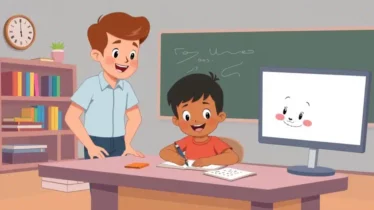Chinese Learning for High School Students (14-18 years)
As teenagers enter high school, their capacity for language learning evolves significantly, offering unique opportunities for Chinese language acquisition. At GoEast Mandarin, we’ve observed how high school students bring analytical thinking, greater independence, and long-term planning abilities to their language studies—qualities that weren’t fully developed in their earlier years.
The Teenage Brain and Language Learning
High school students possess cognitive advantages that make Chinese learning particularly effective during these formative years. Their abstract thinking abilities have matured, allowing them to grasp complex grammar concepts and recognize patterns in character formation. Furthermore, their metacognitive skills enable them to monitor their own learning process and develop personalized study strategies.
While younger children may absorb pronunciation more naturally, teenagers compensate with stronger analytical abilities. They can systematically approach tone distinctions and quickly build connections between new vocabulary and existing knowledge. This critical period also coincides with identity formation—a process that can be enriched through engagement with Chinese culture and language.
One 16-year-old student at GoEast initially struggled with memorizing characters until she connected them to her interest in Chinese history, creating memorable stories for each character based on its historical evolution. This personalized approach transformed her learning experience.
Optimal Learning Formats for High School Students
High school students benefit from varied learning formats that acknowledge their growing independence while providing necessary structure:
Structured Classes with Flexibility
Teenagers respond well to clear learning objectives and measurable progress markers. Our high school curriculum establishes concrete milestones while allowing students to pursue topics that align with their personal interests—whether that’s Chinese literature, business terminology, or contemporary culture.
Technology Integration
Digital literacy peaks during the high school years, making blended learning approaches particularly effective. Our students use specialized apps for character practice, participate in virtual language exchanges with peers in China, and create digital projects that demonstrate their language proficiency.
Immersive Experiences
Short-term immersion opportunities—whether through summer programs, weekend intensives, or virtual cultural exchanges—provide the concentrated exposure that accelerates language acquisition. These experiences are particularly valuable for high school students as they’re developmentally prepared to navigate cultural differences independently.
Peer-Based Learning
The social nature of teenage development makes collaborative learning highly effective. Group projects, language partner arrangements, and study groups tap into teenagers’ natural inclination toward peer interaction while building their communication skills.
Age-Appropriate Curriculum Focus
The high school curriculum should balance linguistic fundamentals with content that resonates with teenage interests and academic goals:
Academic Chinese
Many high school students pursue Chinese with college applications or future careers in mind. Our curriculum incorporates academic vocabulary, formal writing structures, and preparation for standardized tests like the HSK (levels 3-5) and AP Chinese examinations.
Contemporary Culture and Media
Connecting language learning to modern Chinese youth culture—including music, films, social media trends, and technology—creates natural motivation. We’ve found that incorporating discussions about Chinese apps like WeChat, Douyin (TikTok), or analyzing lyrics from popular C-pop songs significantly increases engagement.
Career-Oriented Content
Forward-looking high school students appreciate curriculum elements that connect to potential career paths. Industry-specific vocabulary modules covering business, technology, environmental studies, or international relations help students envision practical applications for their language skills.
Critical Thinking Through Language
Rather than merely memorizing phrases, high school students are ready to engage with ideas through Chinese. Discussions about social issues, cultural comparisons, or philosophical concepts in simplified Chinese develop both language proficiency and critical thinking skills simultaneously.
Addressing Common Challenges
Balancing Chinese with Academic Demands
High school students juggle multiple academic priorities. Our flexible scheduling options, including weekend classes and self-paced components, accommodate busy academic calendars. We emphasize quality of practice over quantity, teaching efficient study techniques that yield results without overwhelming students.
Maintaining Motivation Despite Plateaus
Language learning progress rarely follows a linear trajectory. We prepare students for inevitable plateaus by celebrating small victories, setting varied short-term goals, and connecting language milestones to personal interests. One effective approach involves “language mentors”—slightly more advanced students who share strategies that helped them overcome similar challenges.
Character Acquisition Strategies
While alphabet-based languages require learning roughly 26 symbols, Mandarin demands familiarity with thousands of characters. We employ specialized character learning techniques for teenagers that leverage their pattern recognition abilities, including component analysis, etymology exploration, and technology-enhanced spaced repetition systems.
Benefits Specific to High School Chinese Learning
College Application Enhancement
Universities increasingly value language proficiency—particularly in critical languages like Mandarin. Beyond transcript enhancement, Chinese studies demonstrate intellectual curiosity, cultural openness, and commitment to challenging academic pursuits.
Early Career Advantage
Business internships and entry-level positions often seek candidates with basic Mandarin skills. Even intermediate proficiency can distinguish students in competitive fields like international business, technology, or global development.
Cognitive Benefits During Critical Development
Research consistently shows that bilingualism enhances executive function, particularly when the languages are structurally distinct (like English and Chinese). These cognitive advantages—including improved attention control, mental flexibility, and multitasking abilities—complement academic development during the high school years.
Global Perspective Development
Language learning inherently broadens perspectives. High school students studying Chinese develop nuanced understanding of cultural differences, historical contexts, and alternative viewpoints—skills increasingly valued in higher education and professional environments.
Heritage vs. Non-Heritage Learners
The high school years often reveal significant motivation shifts for heritage learners—students with Chinese family backgrounds. Many teenagers develop renewed interest in their cultural heritage, seeking language skills to connect with extended family or explore their identity.
For non-heritage learners, high school offers sufficient time to develop meaningful proficiency before college applications. These students typically progress through structured levels while building practical communication skills.
Our curriculum accommodates both pathways, with separate tracks that address the unique needs of each group while providing opportunities for collaborative projects that leverage different strengths.
Supporting High School Chinese Learning at Home
Parents play crucial roles even as teenagers seek independence:
- Facilitate authentic language experiences: Attend community cultural events, arrange conversations with native speakers, or encourage participation in Chinese-language activities.
- Connect language to personal interests: Help students discover Chinese resources related to their existing passions, whether that’s sports, music, technology, or literature.
- Respect the learning process: Language acquisition involves making mistakes. Create an environment where teens feel comfortable practicing without fear of judgment.
- Model language learning attitudes: Demonstrate curiosity about Chinese culture and language, perhaps by learning alongside your teenager.
Chinese Learning Progression for High School Students
The table below outlines typical progression expectations for high school students based on our experience at GoEast Mandarin:
| Level | Character Recognition | Speaking Ability | Reading Comprehension | Writing Skills | Cultural Competence |
|---|---|---|---|---|---|
| Beginner (0-1 year) | 150-300 characters | Basic conversation, self-introduction | Simple texts, dialogues | Character formation, short messages | Cultural fundamentals, holidays, etiquette |
| Intermediate (1-2 years) | 800-1200 characters | Extended conversations, expressing opinions | Short articles, adapted materials | Paragraphs, simple essays | Cultural comparisons, historical context, regional differences |
| Advanced (2-4 years) | 1500-2500 characters | Discussions on abstract topics, presenting arguments | Authentic materials, news articles | Essays, formal correspondence | Contemporary issues, literary elements, cultural nuance |
Conclusion: The Long-Term Perspective
High school Chinese learning represents a significant investment in a student’s future. Beyond the immediate benefits for college applications, the language skills developed during these formative years can serve as a foundation for university language studies, international careers, and lifelong cultural engagement.
At GoEast Mandarin, we witness how teenagers who commit to Chinese studies develop not just language proficiency, but also enhanced metacognitive abilities, cultural sensitivity, and a confident approach to complex challenges—skills that transfer to countless academic and life pursuits.
If your high school student is considering Chinese language learning, we invite you to explore how our specialized curriculum addresses the unique developmental strengths of teenagers while preparing them for future academic and professional success.



